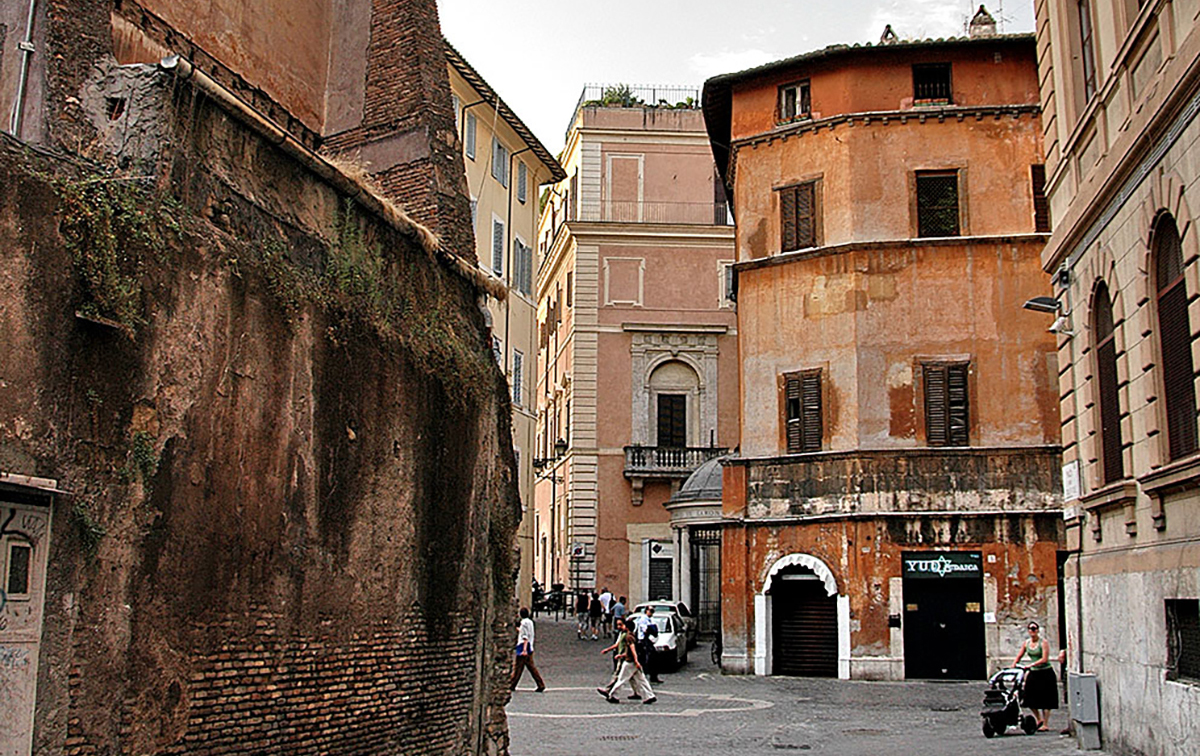
Updated: Date
Published: May 2013
Must be a Canuck, eh?
A Rome tour guide with attitude, knowledge, artistry and panache
Analysis by DAPHNE LAVERS
Writing from Toronto
So you think only famous singers, models and fashion designers go by their first names? Then you haven’t met Garth, likely the most knowledgeable Canadian in the world when it comes to Roman art and history. It’s no wonder he doesn’t need a family name or advertising to stay fully booked as a tour guide in Rome.
He takes clients by reference only, and it’s best to know beforehand that his time matters, that punctuality is necessary and that this isn’t your garden-variety, laissez-faire Eternal City tour guide.
We arrived several hours late for our first meeting with him at the Bologna subway station near downtown Rome. Arms crossed and grim-faced, Garth waited, leaning against a wall. We were late and he was clearly miffed, to say the least. But torrential downpours and 24-hour thunderstorms in Pisa had delayed by two hours our train’s arrival in Rome.
The plan was that on our arrival we were to call Garth, our Rome tour guide whose vacation apartment in Rome we were renting for a week. He would meet us at a stop on the blue subway line, take us to the apartment, give us keys and a brief neighbourhood walk-about.
When we were finally close enough to Rome to call, he was clearly irritated at our lateness. Garth, who does not use the Internet, had no idea which train we were arriving on or from where, and had even less interest in the substantial thunderstorms in Pisa. We were to meet him at the Tiburtini subway station, but on the phone he changed that to the Bologna station – we hoped that wouldn’t be more difficult to find.

When we’d booked our Rome visit, my intrepid husband, Rod, and I wondered how we would recognize a single Canadian in the chaos of a Rome subway system. We had rented his Home-in-Rome apartment for a week, booking him as a tour guide for one of those days, which was to be a walking tour of Rome. We dragged a month’s worth of luggage up the Bologna subway station stairs and along a hallway until we came face-to-face with a middle-aged man in a sports jacket and almost dress pants. The shock of pure white hair and matching beard framing a furious and impatient countenance made for unmistakable identification — this was, without question, Garth!
Artist, teacher, tour guideGarth requested — insisted — that I not use his last name in this article about Home-in-Rome, when I spoke with him in January 2013 while he was back in Toronto for a visit of several weeks. He returns to Canada about twice a year to visit with friends and family.
When Italy joined the European Union, he said, any official tour guide in the EU immediately became eligible to take tourists around Rome, a move which damaged the Italian tour guide sector. Regulations were put in place that non-Italian tour guides were limited to parties of four people or fewer.
Fortunately, we were only two staying at Home-in-Rome, the apartment he owns and rents to tourists for a €150 per night, with stays ranging from a minimum of two nights to the week-long visit we chose, or longer. Garth did have other larger tours on the go, with those tourists staying elsewhere in the city. Hence, the requirement for first-name-only identification.
Garth, a Canadian born and raised in uptown Toronto, is an accomplished artist in his own right — one of his unique impasto paintings hangs in the Vatican Museum. He has degrees from Toronto’s York University in both art and art history. He has lived for over 30 years in Rome, a very natural habitat for the kind of artist he has become. He is married to a Roman university professor, and to Canadian ears, speaks Italian fluently and perfectly, without any accent.
In addition to working as a professional artist, renting the apartment which is often heavily-booked and acting as a daily or multiple-day tour guide, Garth is also an art instructor at the university in Rome. He was very free and refreshingly candid with his opinions, both during our visit to Rome and in my telephone conversation with him early in 2013, imparting unique observations, expert knowledge, information and anecdotal experiences as an artist/tour guide, teacher and hotelier in the Eternal City.
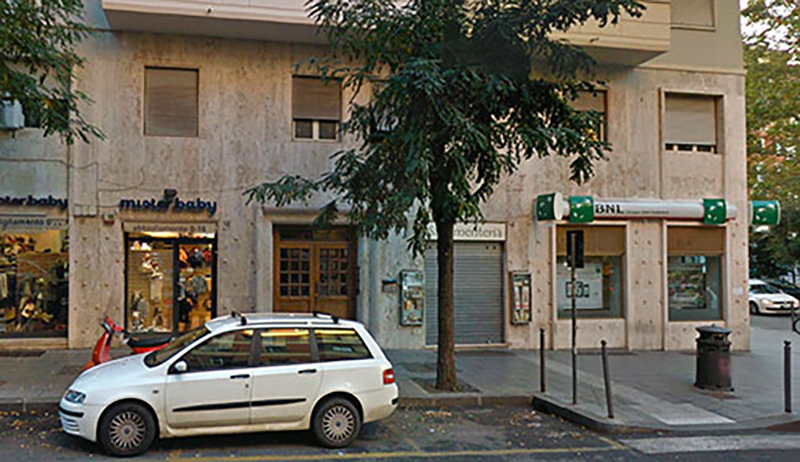
Despite being a rental tourist accommodation, Home-in-Rome is completely equipped, centrally located and filled with beautiful art and furnishings that truly make it a home, albeit a temporary one for visitors. Those factors contribute to Garth’s practice of reservations primarily, if not exclusively, on a referral basis. Our Toronto travel agent had dealt with Garth for years, and booked our one-week stay at Home-in-Rome.
Many of the visitors to Home-in-Rome simply stay there, instead of in a hotel room, and conduct their explorations or business on their own schedule. Others who stay at the apartment also hire Garth for a range of tours, either for one-day walking tours of Rome, as we did, or as part of more extensive bus tours to other parts of Italy.
His own home, only about four blocks from Home-in-Rome, is also a condominium apartment — a contemporary, elegant space with an even more extensive outdoor roof garden retreat than the lush corner terrace his tourist guests enjoy. This proximity provides visitors with a comforting sense of security and helps ensure immediate access in the event of any questions or a need for tour arrangements or for assistance with unfamiliar aspects of Roman living.
Trekking in RomeRome Termini is a massive combination train station, with multiple subway and commuter rail lines, with sleek Eurotrains coming into the station on various levels. Montreal’s train and subway system is comparable, but only in Tokyo had we run across such a vast and complicated complex as this. We managed to get through the train station itself and discovered how to secure subway tickets from automated machines and get them validated. We then trekked down three flights of stairs, then up three flights of stairs, found the right line and the right train, wedged ourselves and our luggage into a hot, overcrowded subway car and managed to get off at the right stop, on the correct side of the tracks.
And having hauled our luggage off the train, up the stairs and then further up the exit ramp where the exit splits off in two directions, there — as mentioned previously — was Garth, who was rather abrupt due to our unavoidable but, no doubt, irritating, two-hour delay in arriving.
He greeted Rod curtly, ignored me entirely, then turned on his heel and walked away, gruffly indicating we should follow. We did, but for only a few steps. Feeling put out, put upon and ignored, I finally downed my luggage, imperiously called a halt to the trek, deliberately and formally greeted Garth — who then acknowledged my existence. I expressed the requirement, demanded, in other words, that we slow down.
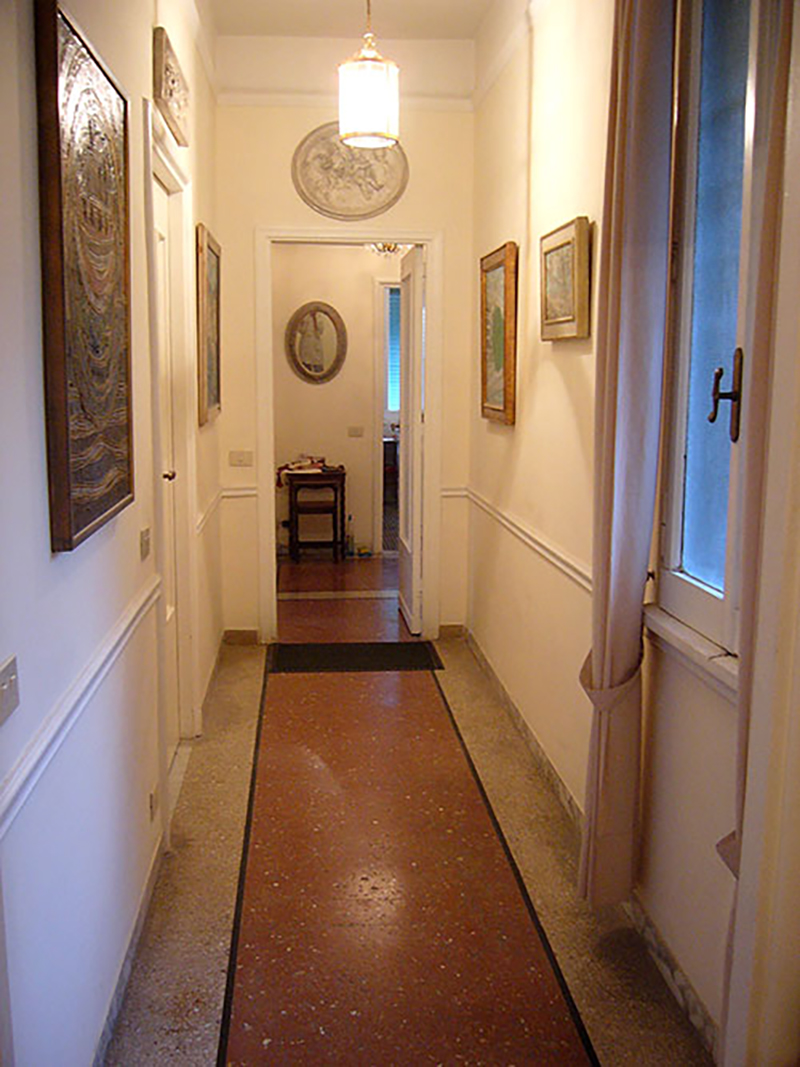
We did. Garth, perfectly appropriately, I determined later, did not offer to help us with any of our luggage. We hurried after him and he immediately began to hold forth about the city, about the neighbourhood, about the subway system — rather as a university lecturer, making sometimes fairly obvious points, sometimes obscure points no visitor would ever know.
A home for the agesIn pale sunshine and Rome heat, we walked uphill from Piazza Bologna along Via Lorenzo Il Magnifico. Built in the 1920s and 30s, Piazza Bologna is not known as a tourist area, but it holds historical significance partially because it is where Second World War dictator Benito Mussolini and playwright Luigi Pirandello lived. It is also where more than 1,000 of Rome’s Jews were herded onto a train for Nazi concentration camps during the war. Ironically, it is now home to a large Jewish population. In the 1970s, Piazza Bologna was known as a neo-fascist epicentre for right-wing attacks against those on the left of the political spectrum.
Garth led us into a typical Italian building in the area with massive, secure, carved double-front entry doors which brought us, thankfully, to a small lift, the workings of which he explained in detail. The ground floor, he said, is T for terra or terrazzo, and the penthouse apartment floor is 5 — which is actually 6 to North Americans.
He pulled closed the single outside door of the lift, prompting the small inside doors to close by themselves. Holding a set of keys, he showed us the front door of the apartment to the left of the elevator. Actually, it was a set of small secured double doors, rather too close for comfort to the edge of a landing at the top of a curving marble staircase with a beautiful, dark green marble railing.
The front door of the apartment, he explained, is steel, for reasons relating to Canadian government people who sometimes stay there. What looked to be about a five-pin steel deadbolt locked the door into the frame. Two-and-a-half turns of an electronic key that cannot be duplicated brought us inside to a hallway with a closed double door on the left marked “Atelier”.
While “atelier” is the French word for workshop, in English it refers to the workshop of an artisan involved in fine or decorative arts. A skeleton key unlocked a larger door at the end of the hallway to the apartment proper, which almost seemed like a gallery where Garth’s works are exhibited.
Pull the chain to flushLocated near the university in an old desirable almost-downtown residential neighbourhood and only about five or six subway stops from the Coliseum, the apartment itself is apparently worth about €600,000, Garth said. He gave us a rapid tour of the apartment, showing us kitchen, master bedroom, small closet-type bedroom, living room/parlour and the large, square, lemon-tree-filled terrace.
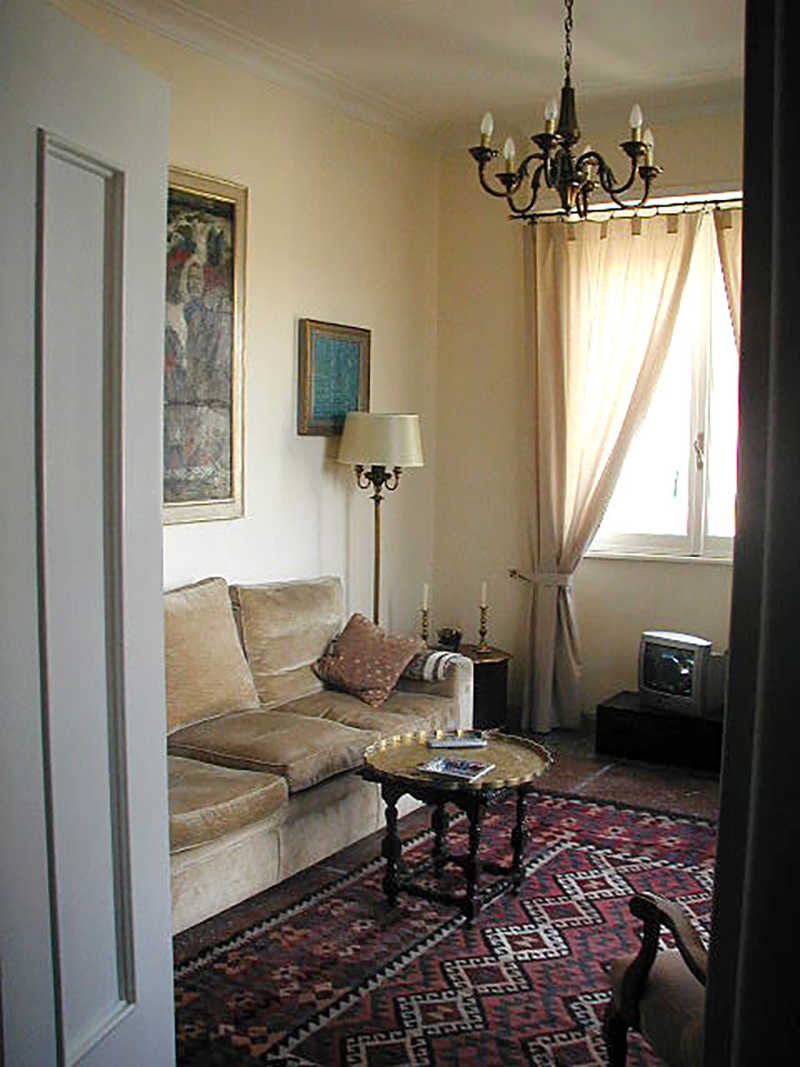
“You know how to work Italian toilets?” Garth asked, only slightly condescendingly. Yes, we did; the water tank for the toilets is mounted high on the wall, near the ceiling and one pulls a chain to flush the toilet by gravity. A wall switch for the small hot water heater, also mounted near the ceiling in the bathroom, is beside the toilet tank. Next to the toilet is the requisite bidet with its own set of small, crisp linen towels.
Then it was out to the street for what was intended, we thought, as a brief and very brisk tour of the neighbourhood. Garth was clearly someone who did not suffer fools lightly. It is a trait I admire. But curiosity being a stronger driver than accommodation of personal style, I asked a number of forceful, pointed and necessary questions, enough to indicate fascination with the city, with his clearly-expansive knowledge base and his intimate familiarity with the neighbourhood.
On a fast-paced walking tour of the neighbourhood, Garth pointed out the corner store which usually — but not always — had subway tokens, a large outdoor vegetable and farmers’ market just a short block behind the apartment, a nearby apartment building pockmarked with Second World War bullet holes which had never been repaired, and a large grocery store near the subway stop.
Garth began to illuminate mundane but interesting cultural differences not at all obvious to tourists, the kinds of things one would never learn staying in a standard hotel and taking a garden-variety Rome tour. For instance, apartment buildings, such as the one where we were staying, have no garbage chutes. The buildings are ancient, solid stone and built long before such things were thought of; householders take their garbage down to the streets and drop it into very large container bins parked along the curbs.
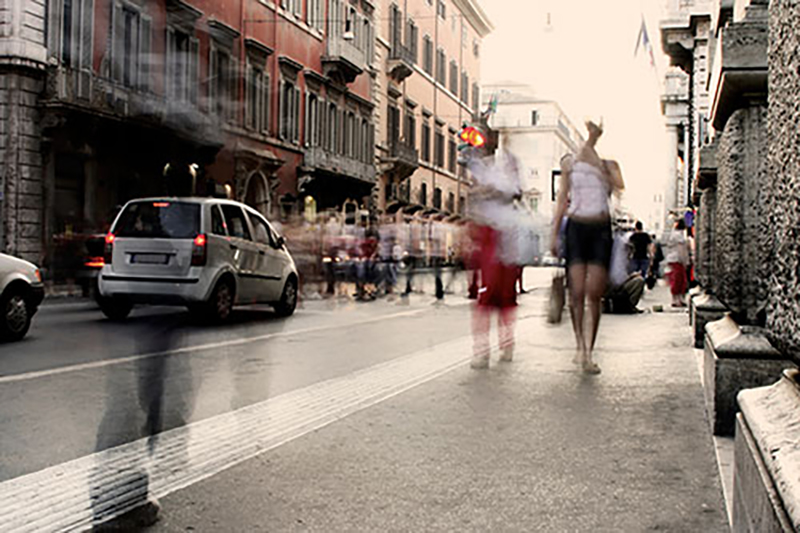
Another difference Garth explained and then illustrated with astonishing aplomb; cars stop for pedestrians. In virtually every neighbourhood, including downtown, with an air of comfortable disinterest and absolute trust, Garth would, without looking, walk off a curb chatting with us, one arm waving vaguely in the direction of oncoming traffic. I hung back on the sidewalk, somewhat aghast, but like the parting of the Red Sea, all traffic came to a halt. Garth assured us that cars stop; there is no question that traffic stops for pedestrians; we had absolutely nothing to worry about. Over and over and over again, he proved it.
Oblivious to traffic, he would walk to the edge of a sidewalk, stride purposefully into the middle of the street, waving in the direction of oncoming cars while continuing his conversation and informal lecture. It seemed rather amazing and improbable to me. I wondered whether perhaps it was Garth’s appearance — an obviously educated, striking-looking figure in business dress — that halted traffic, but it wasn’t. All over the city, I watched carefully as other Romans performed the same feat. Eventually, we tried it ourselves and, like magic, it worked!
Getting to know youFinally, having unwittingly taken up considerably more of his time than the short neighbourhood walk-about Garth had promised, we ended up taking even more of his time as we sat down for cappuccinos at a small local café. Garth seemed mildly surprised that we hoped for his company for our afternoon break, and that we paid — a very polite and natural thing, to my mind — for his coffee and a small treat. And I began to formulate some possible interpretation and understanding of his initially brusque, clipped greeting, compared with his highly-articulate and well-informed manner.
Some of Garth’s guests/clients at Home-in-Rome have been less than stellar visitors. His pleasant surprise at being treated to coffee, a very small gesture, was only a first indicator of the reasons for his initial business-like coolness towards arriving clients. His previous apartment clients, just the week before, had a small child. Children are clearly and plainly discouraged from staying at Home-in-Rome, which is not set up or intended as a child-friendly location or apartment. The child, Garth stated, locked itself in the bathroom and would not come out. The parents finally kicked in the door, breaking the door frame in the process. They left both the door and its frame for Garth to repair — a somewhat astonishing breach of guest etiquette to my mind.
Another visitor, sadly a Canadian, went shopping at the nearby outdoor market. Garth graciously accompanied her to provide a hand, explanations and to translate. He even helped with carriage service, lugging home bags and bags of groceries. Half a block from the apartment, this particular visitor put her bags down on the sidewalk in obvious frustration — having complained, apparently throughout much of the shopping expedition — and said angrily, “Why don’t these people speak English??!!”
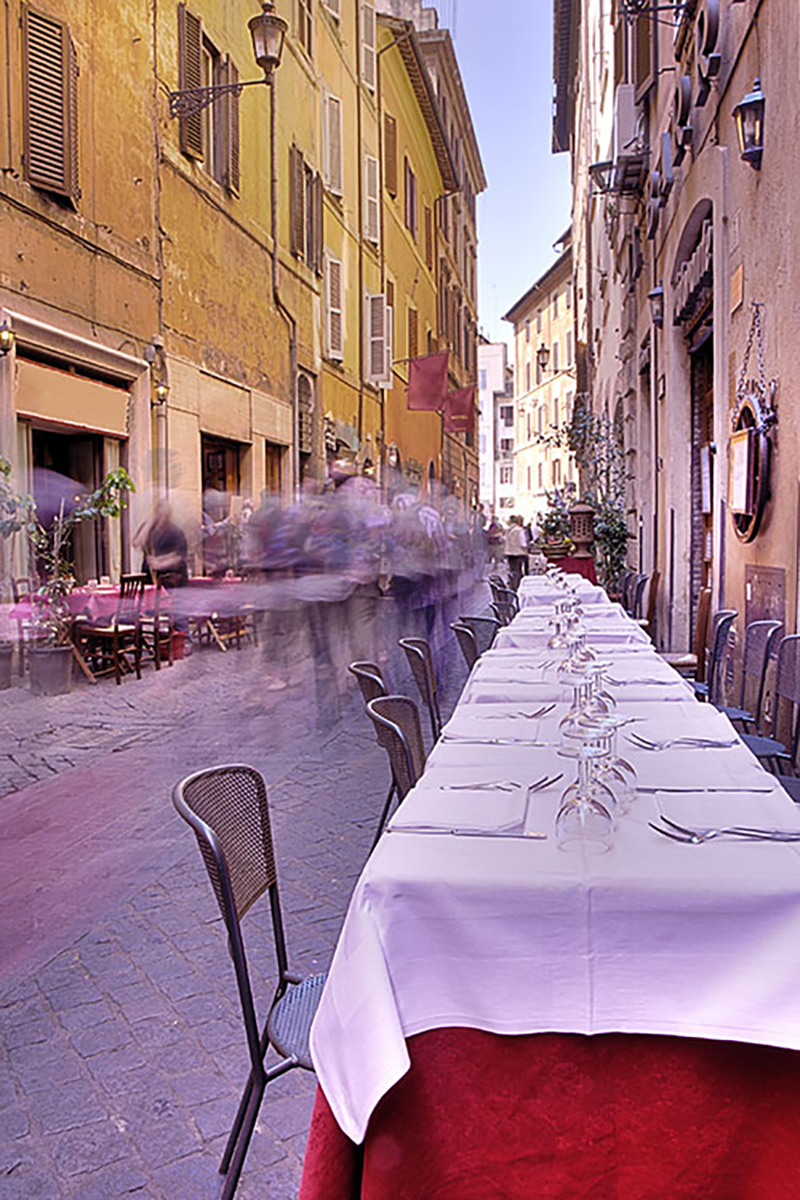
Somewhat taken aback, Garth explained the obvious: “Because they are Italian. This is Italy! This is their country!” The visitor was not impressed; they should learn English, she said huffily.
Ah, I thought to myself, sitting in the café; there was indeed good reason for Garth’s initial brusqueness and seeming impatience.
And there was a third story, among many we would hear that week; a pair of Canadians had come to Rome, hired Garth for the day as a personal tour guide — an experience we also chose, much to our delight and education — such tour being defined as a 9-to-5 walking tour of Rome. While Italian tour guides charge €40 to €45 per hour, Garth charges €150 for the entire day for a party of two. The ladies, for such they were, kept walking, chatting and questioning, past 6 p.m., past 7 p.m., and then finally past 7:30 p.m.
At that point, having dragged Garth around the entire day, they asked his recommendation for a dinner place, which he unstintingly provided and to which he accompanied them. They asked for his translation help in ordering dinner; and then, indicating that his formal duties for the day were finally finished, allowed as to how they would “generously” buy him a glass of wine at the bar to thank him for his extra work, time and effort. He was dismissed.
Good Lord, I thought, sitting at the café. What appalling behaviour. I was glad that Garth was Canadian and that we were Canadian — so that he would know without being told that all Canadians are not so unmannerly and crude. He did.
Tells it like it isThere are a number of unique things about Garth, his apartment and, of course, the Eternal City.
Garth is firmly of the opinion that most tour guides have little knowledge and no training, including Italian tour guides. And quite frankly, compared with Garth, that indeed seemed to be the case, with a few notable exceptions in other parts of the country. His own profession as an artist, combined with his academic training and art degrees added a dimension to the experience of touring the city and staying at his apartment that was absolutely and richly unique.
“Most Italians, and Italian tour guides, will tell you that the Coliseum was destroyed in an earthquake,” Garth said. Most reference books and online guides reiterate this — that the Coliseum was hit by lightning, earthquakes and then vandalism, in which all the marble was removed over the centuries by thieves. “It wasn’t an earthquake! The Coliseum was dismantled piece by piece to build St. Peter’s Basilica!”

Garth tours visitors not only in Rome, but in Venice, Florence, Pompeii, Capri in the south and other exquisite Italian cities, often travelling with bus tours. In addition, he teaches art history at an American university in Rome called Renaissance Art History, an intensive full-credit, five-week course in session six to seven days per week.
His classes, like his tours, are peppered with historical and artistic anecdotes, one of which concerned a tour of Italy by Jimmy Carter, U.S. president between 1976 and 1980. One of Garth’s American students asked, puzzled: “Jimmy who?” I could, by now, envision Garth’s eyes rolling in despair. The essence of the story was the pointless transport by the U.S. Secret Service of the president’s bullet-proof limousine to Venice, which has no roads, only rivers and canals.
The students did not understand the significance. Garth explained, no doubt painfully, that there are no roads in Venice; the old city is traversed only by walking, by private gondola or by the “vaporetto” city boat service that runs like city buses around the Venetian canals. His students did not believe him. “Don’t be stupid; they have to have roads!” was the response. I couldn’t help but smile, having already visited Venice…where there are, in fact, no roads and no cars in the old city.
One other unique and absolutely invaluable component to Garth’s hotelier/tour guide persona — he provides visitors to his apartment with a cell phone and his own phone number. If during your week, you run across something unmanageable or confusing, you can actually phone him, which many guests do. He will, without hesitation, explain an entrée on an Italian menu, describe which subway stop you need or confirm several nearby restaurants suitable for lunch or dinner — a unique addition far above the conventional duties of a guide.
Another thoughtful component of Home-in-Rome is a small bookcase of English-language pocket books, including a couple of detective novels focused on a Roman detective — quite appropriate and appreciated for week-long stays.
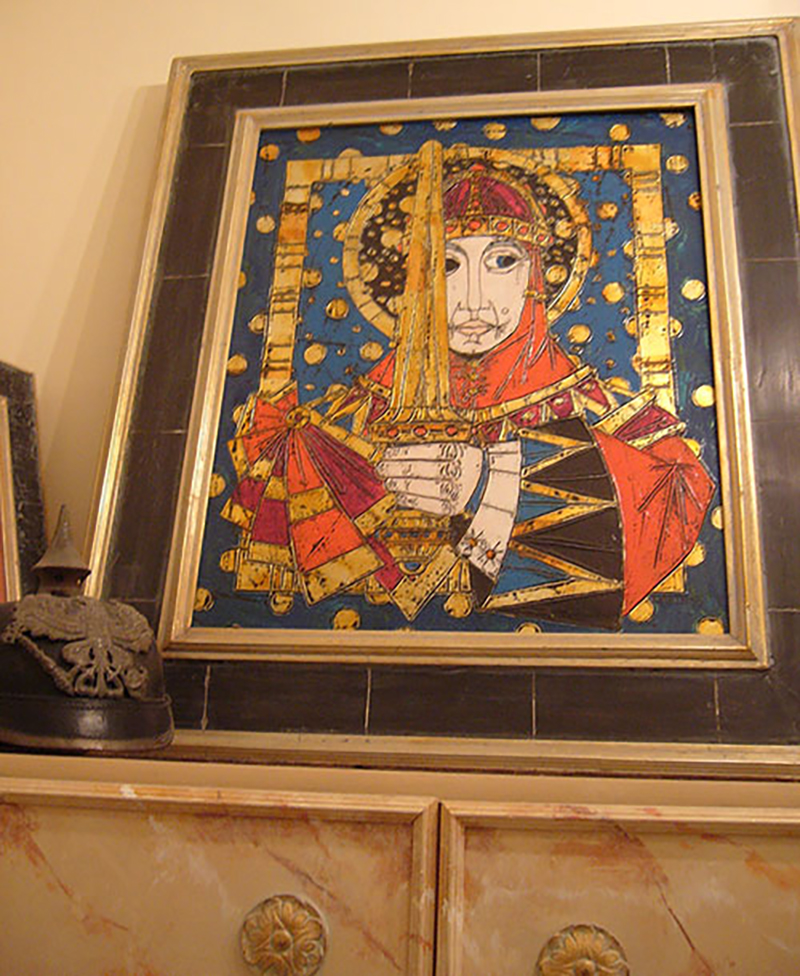
Garth’s own artistic style is called impasto — in relief with a textured surface. This technique of Italian origin, he described, was used in fresco wall paintings and in pre-Renaissance wood panel paintings of the 13th, 14th and 15th centuries.
Impasto has been called a type of sculpture, but done by painters and on canvas. A design or image is worked or incised onto a relief surface which has been applied to a canvas, rather like a layer of wood upon which the artist carves an image while the surface is wet. Once the surface with the incised design is dry, it is reworked and painted with translucent layers of soft and luminous acrylic paint, Garth told us.
In a number of his paintings, Garth uses gold leaf. Combined with some of the brilliant, gem-like colours of acrylic and the lines literally carved in the surface of the canvas, his paintings are jewels with a dimensionality and gorgeous tonality reminiscent of the illuminated manuscripts of the Middle Ages.
In pursuit and continuing development of his own artistic style, Garth took the time to formally study the almost-forgotten art of hand-framing and the very ancient art of guilding in one of the few places left where one can find such expert artisans — Florence, more properly called, in Italian, Firenza. His frames are an integral part of each painting, designed and executed specifically for each subject.
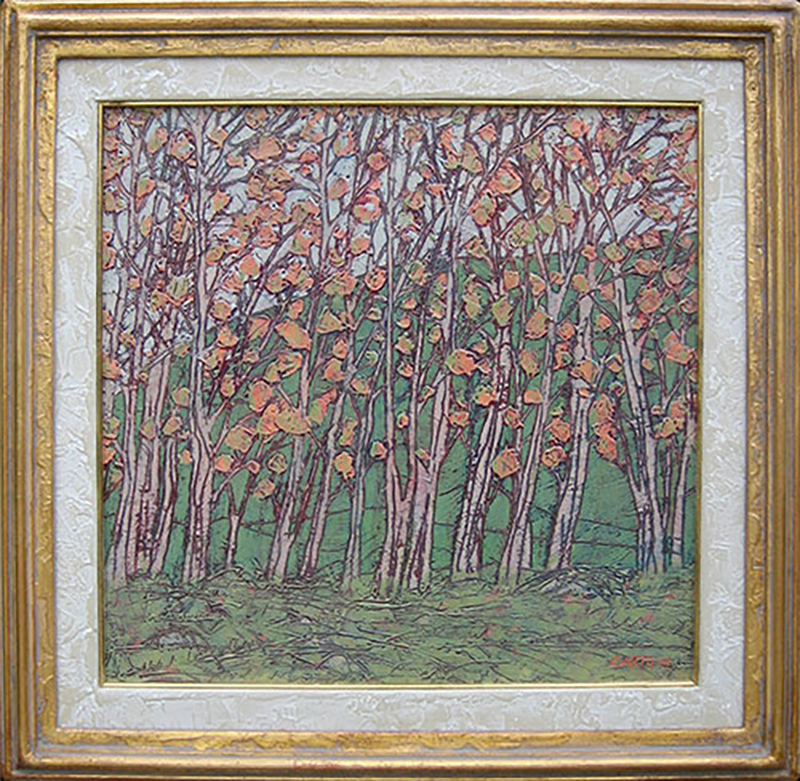
The colours are literally jewel-like, and the scenes are almost three-dimensionally luminous. Garth considers himself a contemporary artist, but at least some of his work evokes the magnificent frescoes and brilliantly-coloured medieval stained-glass images found in Italy’s cathedrals. He paints landscapes and human figures “but never human figures in a landscape because humans date the painting…; without them, a landscape is timeless,” he said.
So Garth is an accomplished artist in his own right, a long-time student and a teaching professional of both art and art history. His art and art history degrees from York combined with his fluency in Italian, his on-going and intensive study of Roman and Italian history and his own long-time residency in Rome make for an exceptional tour guide.
An artful apartmentThe apartment in Rome is beautifully adorned with Garth’s art, each painting looks like an exquisite treasure selected and procured from some of the great homes, cathedrals and public buildings of Europe. It is like living in an art gallery of beauty.
The rooms are not huge, but comfortable. At the entry door into the apartment is a small square centre hall. Leading off it is a wide galley-style kitchen with large windows and shutters at the end. Down a smaller hall is a bathroom with a long bathtub, a wall-mounted, curtainless shower, and the requisite bidet and sink. A pair of shuttered, tall-to-the-ceiling windows open onto an interior courtyard.
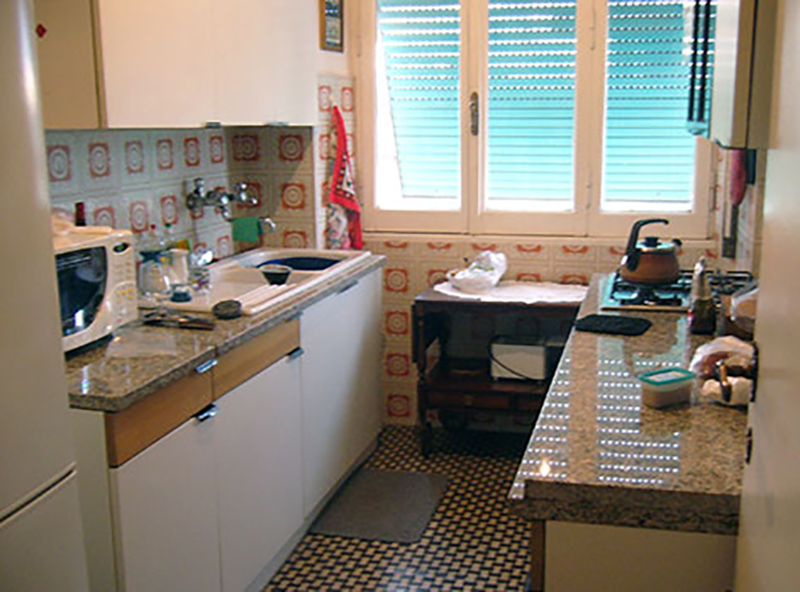
The master bedroom is spacious with an elegant standard double bed, a 10-foot-tall antique double armoire along one wall with bedding galore, a rod for hanging clothes and a trunk under the double-paned high windows across one wall. Green metal awnings on the outside of the windows provide complete privacy. Old Italian homes, Garth said, were not built with closets, hence the massive armoire.
The floors throughout are terrazzo — irregular chunks of stone and marble set into the floor with wide irregular grouting, smoothed and polished flat. But the stone floors in each room are edged with about an eight-inch cream border, inside of which is a black marble line, and then the colourful terrazzo that makes the rooms look elegantly bordered and carpeted. Area rugs lie atop the stone.
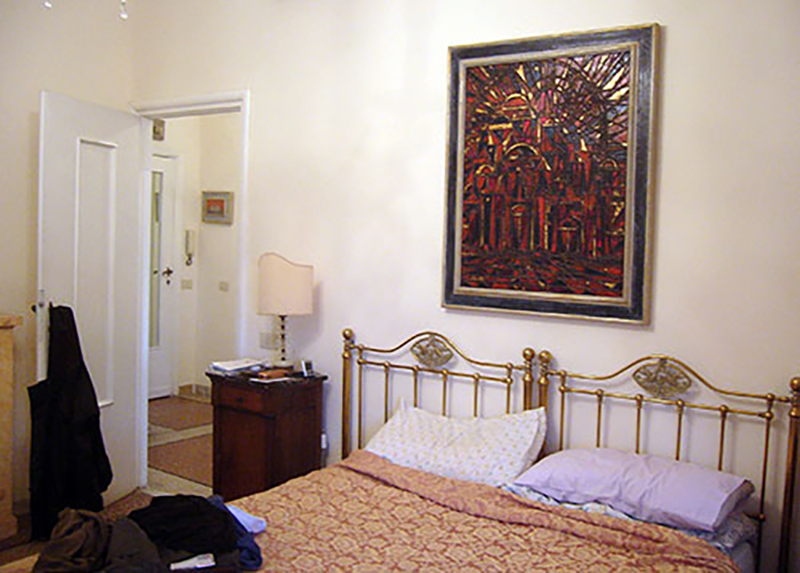
The dining-sitting-living room space is cozy, elegant and comfortable, defined by a red Persian area rug on the terrazzo floor. A plump couch and a coffee table framed by antique dark wood with a large intricately embossed brass Egyptian tray on it sat near a corner with a small square dining table covered in thick gold brocade. The room also had a straight-backed chair upholstered in aging gold velvet, and a tiny 10-inch television (who in their right mind would waste time watching Italian television while visiting Rome?). Large 10-foot-high double doors lead out onto a terrace. And art, Garth's art mostly, are all over the walls, like a gallery.
The terrace is accessed from the main living area through tall, floor-to-ceiling, double-glass doors in heavy solid wood frames. Solid steel sliders lock at the top and bottom providing excellent security. In addition, there is an ornate, black wrought iron double door that provides open-air comfort with a highly secure lock that takes four turns to close. The key resides on a nearby wall hook so one can leave the glass doors open all night in complete safety. Clearly, however, no one is concerned about insects, rodents or birds getting in because there are no screens and, in fact, none were needed.
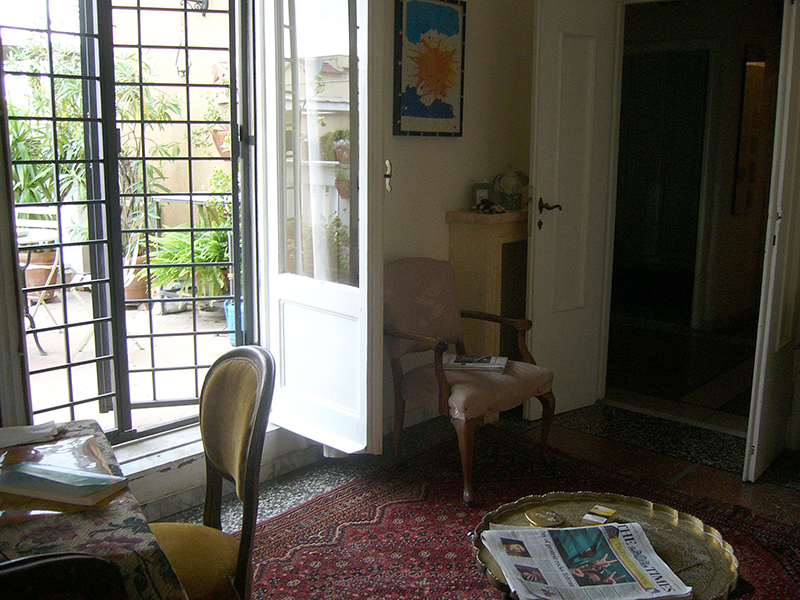
The private, generous corner terrace is stone-floored and edged with a host of potted plants in stone or terra cotta pots that create the ambience of a garden. Lime and lemon trees, an olive tree, ornamental flowering bushes are complemented by ivy in a long square planter box which climbs up a horizontal wrought iron trellis. All made the terrace into a fairly private garden. A small bistro table with an oval marble top and four steel bistro chairs provides an outdoor dining room.
A deep square ceramic sink is hidden in one corner by plants and the terrace has its own watering system on an automatic timer, which means visitors don’t have to even think about giving water to the plants. Two black wrought iron coach lights on the walls illuminate the terrace for nighttime reading.
Meet the neighboursSaturday night in the apartment was unique, like a small town neighbourhood on a weekend evening. Dogs barked, a man drove his scooter up the sidewalk, a car stopped at the corner. A stereo blared, but instead of hard rock or punk crap, the music was a beautiful classic pop melody.
A group of young people wandered slowly up the street chatting, and neighbours held conversations on several street corners. The human scale of the place was evident; the apartment building was seven storeys high, the same as the one across the narrow street to the north; kitty-corner, stood a six-storey, and directly across was a five-storey. No towers, no monster non-human 40- or 50-storey buildings in sight; down the streets in all directions were small-scale buildings with decks open or shuttered, and drapes open or half drawn.
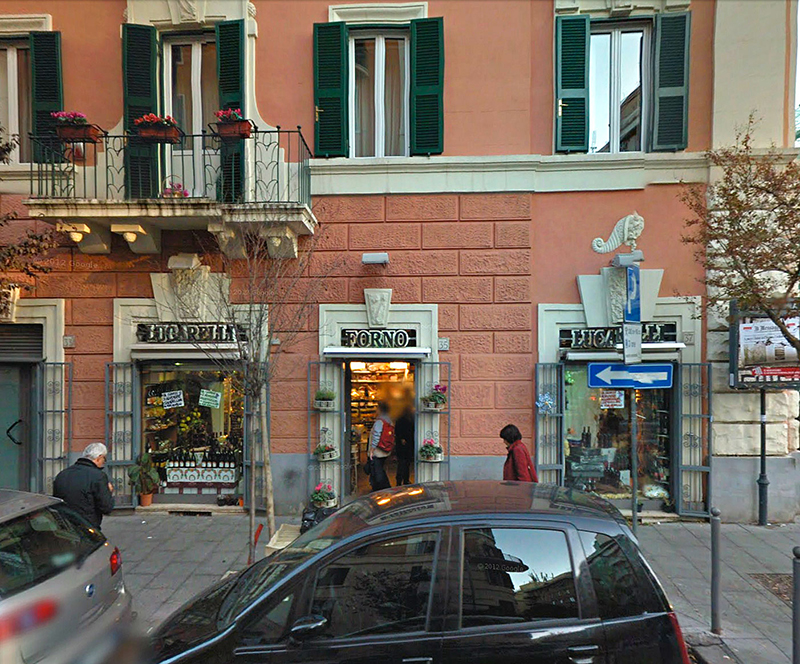
Just up the street, a couple of short blocks between the apartment and the subway, was Forno Lucarelli. “Forno” means oven or bakery, and Forno Lucarelli was, to my eyes, a most exotic food store. A paneterreria (bakery); a pasticceria (confectioner or pastry shop); a salumeria (butcher shop); a pizzeria and a wine shop combined into one offered all kinds of breads, cold meats, prepared dishes, pastries, olives, cheeses, panini — a feast for the eyes and a pleasure to deal with. Most of the staff members spoke English and were gentle and helpful with our efforts at Italian. On our first visit, a young woman came up to us with samples of an Italian truffle-type cake, and two small glasses of wine to taste. A couple of nights later, a sample of bonconcini cheese was offered and other gentle suggestions as to what would complement our selections.
A tour with styleWe had booked Garth as a tour guide for a one-day walking tour of Rome, to take place several days after our arrival. He called the night before to confirm, and came to the apartment to pick us up right on time at 9 a.m.
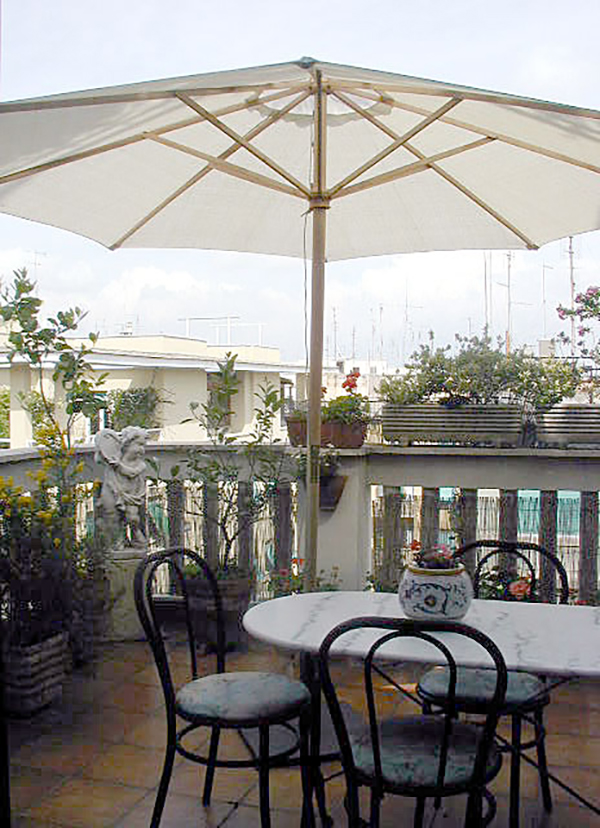
We took the subway a few short stops to the old part of the city and then walked for the entire day. Garth figured we would walk about 6 kilometres; I estimate we walked double that. Through the streets, byways and alleys of Rome — narrow little cobbled streets, some closed and shuttered, others open with shops, and some with huge portal doorways which gave access onto exquisite courtyards.
Garth escorted us to all the well-known sights that visitors to Rome want to see, from the Vatican to the Trevi Fountain, the Coliseum to the Palatine Hills. But as befits the planning of a long-time resident Rome guide who is also an artist and an historian, he showed and taught us about places and people your typical Rome tour would never find.
Garth’s style is that of a university lecturer, but one who assumes (usually rightly so) that his audience is fairly unfamiliar with the city or the country. He is an expert who is brimming with facts about everything he chose for us to see.
The tour included some shops, both chic contemporary designer ones, as well as small, exclusive clothiers. One, which appeared to be an unprepossessing little store with a single evening gown on display in the window, turned out to be where Sophia Loren buys her “frocks” — stunning, custom-made, floor-length gowns designed for attending the opera.

One shop was given over entirely to exquisite, hand-made Roman tassels — tassels for heaven’s sake! — the most exotic and exquisite ones, I'm sure, on earth, used for fan pulls, light fixtures, keys, or drapes. I recognized the tassel that made it impossible to misplace the apartment’s key to the wrought iron terrace doors.
Another specialty shop had over 100 varieties of ice cream and gelato made on the premises with the most varied flavours imaginable. And yet another specialty candy shop had suckers in unique and sometimes questionable forms — one could, for example, lick a sucker with the face of the Pope!
The urban landscapeIn terms of their homes and residences, Garth explained, Italians are much more “interior focused” than the rest of the world, North America in particular, which is exterior focused. And this was where the unusual advantage lay in wandering Rome with a Canadian artist, resident in the city and perceptive enough to observe, ponder and identify both obvious tourist destinations, along with the character and psyche of Italians compared with nationalities of other Western countries.
For example, a massive double portal door set into a blank wall of ancient stone would open onto a beautiful square interior courtyard. Filled with trees, grass, flowers and stonework, these courtyards often included a fountain or two, connected directly to the pure water of Rome's aquifers. The courtyard would be five to 10 degrees cooler than the street outside.
Inside these beautiful, peaceful and safe courtyards are where lives are lived. Garth explained that the exterior of a home is of little interest to most Italians, unlike North America where impressive, showy exteriors are the norm. The Italians, Garth said, learned that if you don’t show off what you have, it is much less likely that anyone would try to take it away from you.
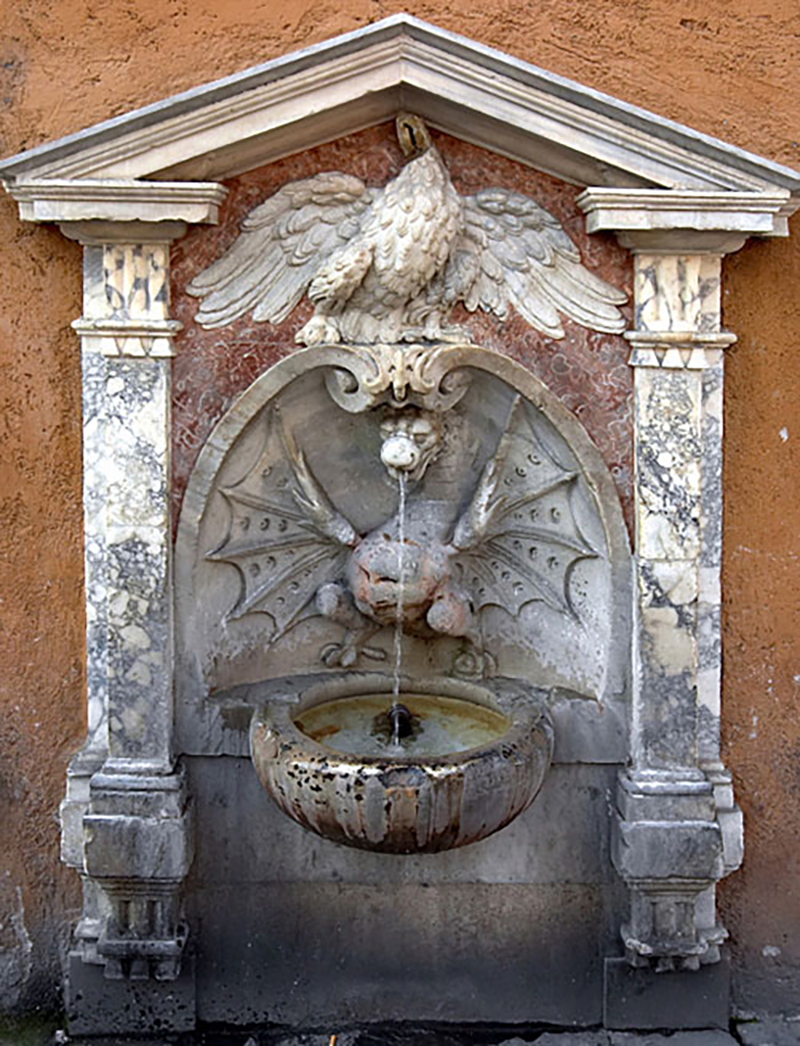
Decorative, artistic drinking fountains are situated throughout the old part of the city. According to Garth, they connect to huge water mains built in Roman times which continue to provide clean, fresh drinking water to anyone and everyone travelling the streets.
Garth knew a number of people whose paths we happened to cross on our downtown walk, from restaurateurs to shopkeepers. At one point, an unidentified member of Italy’s elite drove into a private courtyard area as we passed, stopped to chat with Garth for some considerable period of time and allowed us to see the private and enchanting courtyard.
In one narrow, cobbled street, Garth stopped and called up to a window on the second floor. An older man appeared at the window; they spoke in Italian, and Garth took us up a polished, narrow marble staircase to a place no tourist would ever see. It was a custom jeweller he had dealt with for 25 years, in a tiny room perhaps 15 feet square, with an ancient work table across one side and a miniscule office at one end with some kind of very small desk.
A younger man worked on very fine filigree gold at the ancient workbench, while Garth chatted with the jeweller. Garth had confessed a fondness for antique jewellery, whereupon the jeweller had found an Elizabethan ring which Garth had purchased for his wife. While we visited, the jeweller was repairing and replacing very tiny sections of filigree gold ornamentation that surrounded square diamonds set around a ruby. It was an astonishing little workshop and miniscule laboratory.
A slice of historyThroughout Rome the letters “SPQR” appear: on pavement, on plaques, carved into stone above the entrance to buildings. Garth explained that the letters are Latin for “Senatus Populus Que Romanus” — the Senate and the People of Rome. But, he continued with a smile, less generous souls have interpreted that abbreviation over the centuries with less precise translations such as: "Sono pazzi questi Romani", which translates into "These Romans are crazy." Or "Solo preti qui regnano", meaning "Only priests rule here." There are other, much cruder translations which I will not repeat!
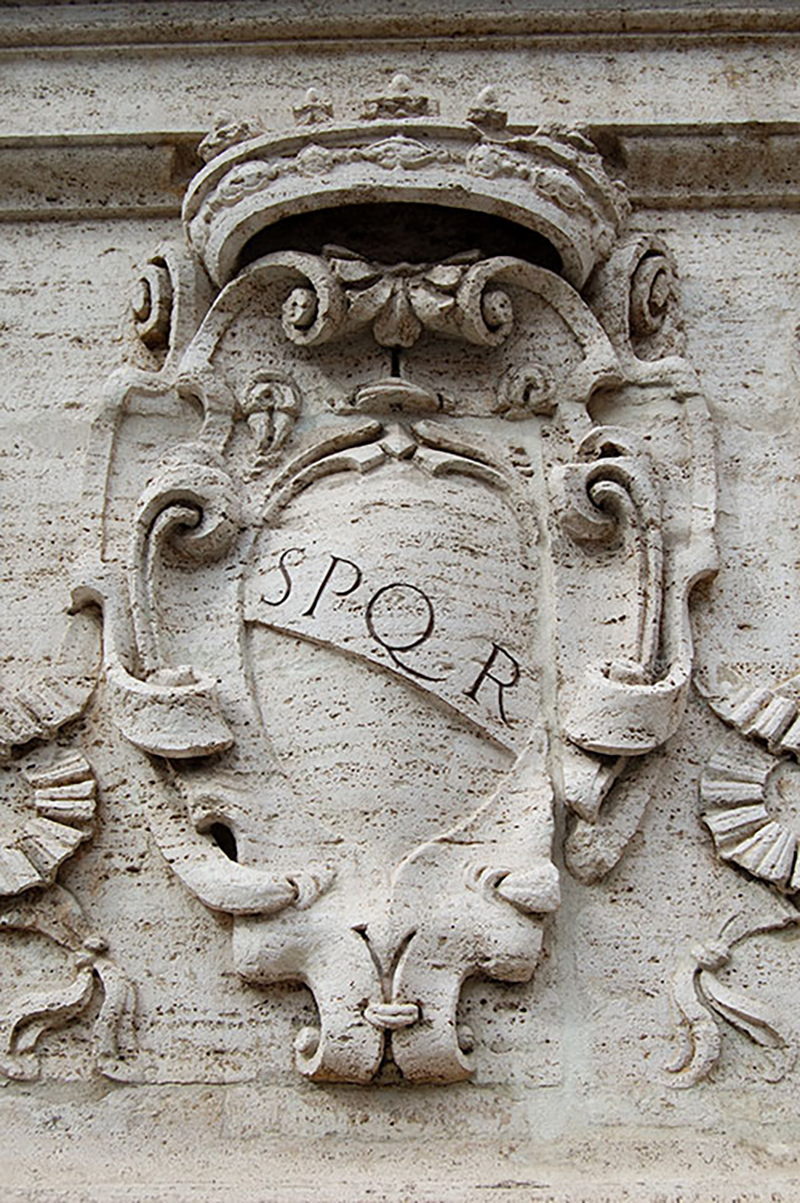
And Garth shared other historical curiosities, among which was the astonishing fact that the laws of the Inquisition, instituted in medieval times, have never been repealed. They remain, if unobserved, legally in effect in Italy.
We walked the Jewish ghetto, mostly closed for Rosh Hashanah (the Jewish New Year), the day of our visit. But the Jews also seemed conscious of not revealing what they possess. This sect of Jews, Garth said, is the oldest in the world, the refugees from Maceda (also called Masada), unknown in the West.
While history asserts that all the Jews in the Maceda fortress, located in the Judean Desert overlooking the Dead Sea, committed suicide during a Roman siege around 73 or 74 BCE, some historians found evidence of seven survivors — five women and two children — and postulate that a few others may have fled prior to the final Roman assault on the fortress. This sector of the city is protected with iron pedestrian gates at each entrance because in the 1970s Yasser Arafat, chairman of the Palestine Liberation Organization, sent machine-gunners in cars careening through the ghetto firing at Jews.
Familiar with contemporary history, as well as ancient history, Garth noted the place where the body of assassinated five-time Italian Prime Minister Aldo Moro was dumped in the heart of the city in 1978. Moro was murdered by the Brigate Rossa (Red Brigades), a left-wing extremist group.
The Pantheon, originally built as a temple for all the pagan gods but a Christian church as of the 7th century, is one of the most visited sites in Rome. It has one of the largest unreinforced concrete domes in the world, built by the Romans long before the invention of rebar. Around the corner, just steps from the Pantheon, an unobtrusive little church, the only Gothic church in Rome, Santa Maria Sproa Minerva, in which is casually situated a statue by Michelangelo. It is the only such work by Michelangelo where one can actually get close enough to touch it.
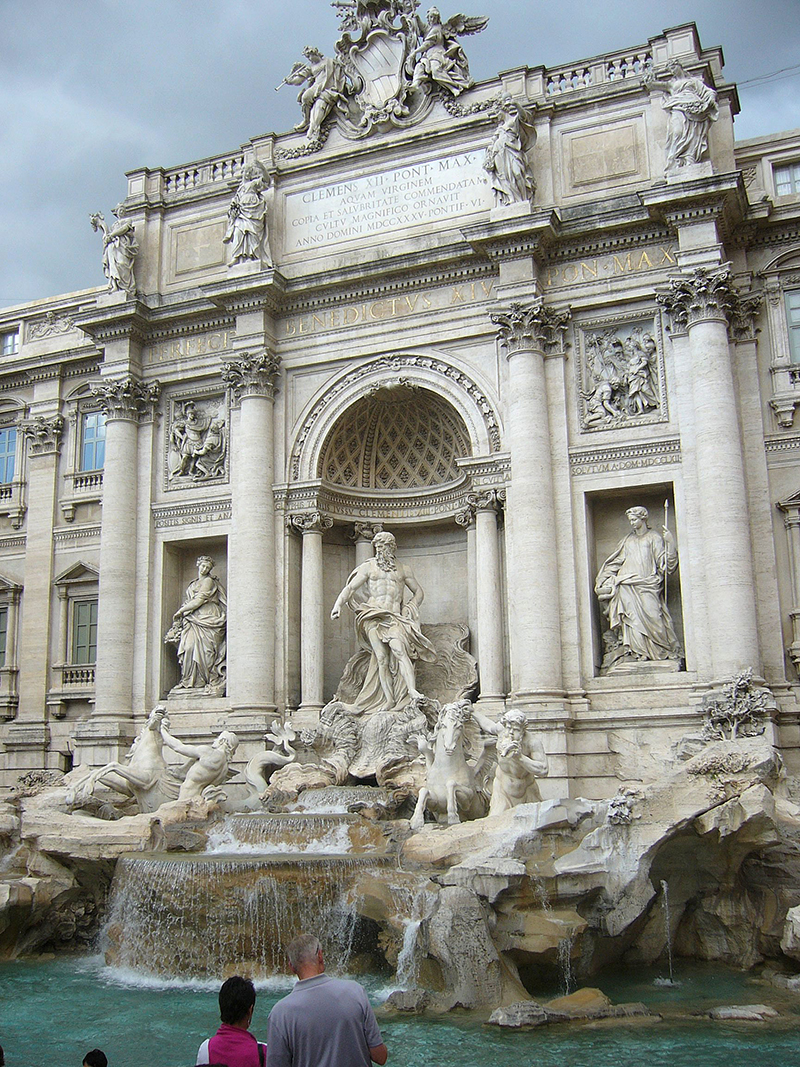
Garth took us to the famous Spanish Steps and the Spanish embassy, where tourists lounge with espresso to take photographs. He toured us through the Coliseum, that terrifying monument to Roman power and cruelty which was possibly the first covered stadium in history. Huge canvas sheets were pulled over the roof by slaves to protect spectators from the burning sun, Garth described, while leaving the combatants roasting and illuminated in its glare. Below ground, three levels of caverns, corridors, warrens, cages and caves confined both animals and combatants before their battles. In one three-month span, Garth said, 10,000 gladiators died on the sands of this stadium.
I do not know if we were somehow special visitors to Garth’s apartment hotel, but our tour generously lasted until well after 7 p.m. Instead of being returned to what by then felt like “our” apartment, we were, to our surprise and delight, invited back to Garth’s own home and welcomed by his wife, the science professor, and his daughter, an architect and potter. It was an even more exquisite art gallery of a residence, where we continued our fascinating, animated discussion about politics, art and history over glasses of homemade iced lemoncello.
Shortly thereafter, our week in Rome came to an end. We reluctantly packed our belongings, tidied up the apartment and caught one of the numerous accessible buses downtown to meet our next tour group heading south to Pompeii, Sorrento and Capri.
This then, was the perfect Roman holiday for a first-time visitor: sufficient time to learn about the city on one’s own; a tour guide from our own country who is fluent in Italian, as well as being a university lecturer and a practising artist. And an apartment which provided us a way to live and learn about everyday existence in the city of Rome.